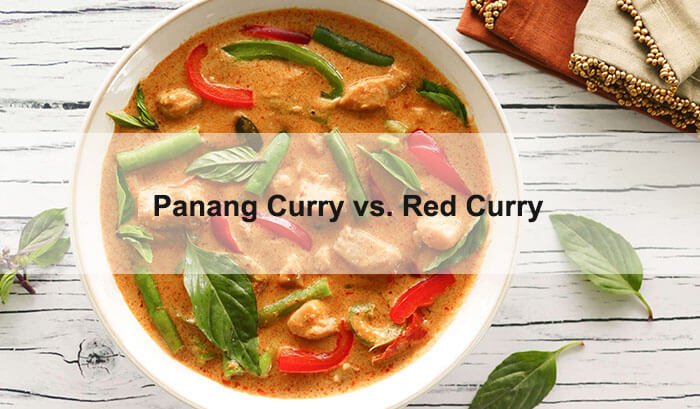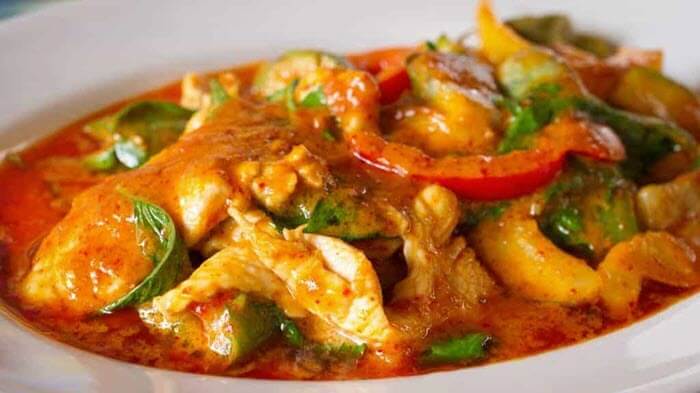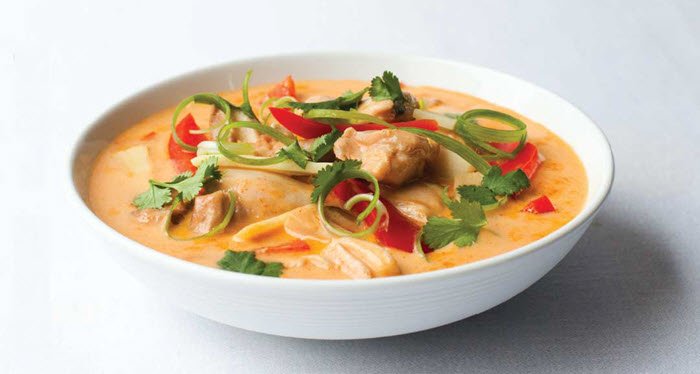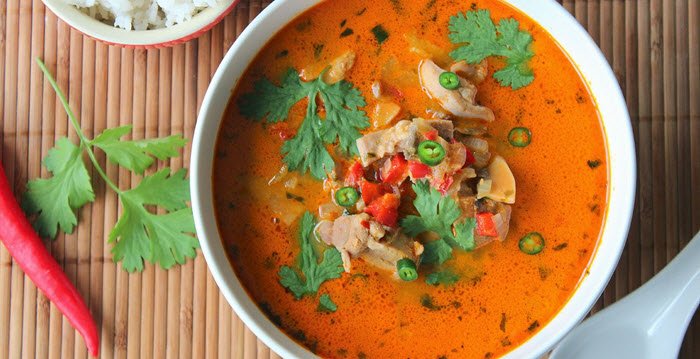One common misconception about curry is that it’s only one type of dish; really, it is a variety of dishes that fall under the category of curry.
Curries are a popular Indian and Thai cuisine, featuring varying levels of spiciness.
Another typical mistake is believing red curry to be the same as Panang curry.
When it comes to Panang curry vs red curry, it’s essential to know what kind of differences they might have.
Table Of Contents
Panang Curry vs. Red Curry: What’s the Difference?
We’ll compare Panang curry paste and red curry paste in the following criteria.
1. Sweet or Spicy?
Sometimes both! While Panang curry and red curry might share a similar color, they do not share the same spice level.
The reason is that the amount of chilis in each kind of curry vastly changes the level of heat that you get when eating them.
Panang Curry
Often called the sweetest curry, Panang curry achieves its flavors via coconut cream and peanuts. It can have a color similar to red curry, but it’s generally on the milder side.
Red chilis in Panang curry recipes give it that reddish tint, but not necessarily to the same degree as a proper red curry.
However, do not underestimate the heat level of this curry, as it can still hit hard if you are less acclimated to hot foods.
Red Curry
Red curry is a variety of curries, not just one kind, given a red coloration because of the amount of red-tinted chilis used.
However, all are on the hotter end of the spectrum regarding Thai or Indian curry types.
As one of the spicier curries, it is prevalent among curry connoisseurs and relatively easy to distinguish against Panang if you know what you’re tasting.
Red curry is up in heat level with green curry, the hottest, while yellow is the mildest.
Summary
Knowing the difference between heat levels of any variety of curry is imperative to not hurting yourself if you’re just starting to get into eating curry.
Remember to know what you can handle in terms of heat; you can always try hotter foods later if you continue to eat milder spicy food and acclimate your tastebuds!
If you’re new to spicy food or curry, starting with a yellow curry might be more advisable.
2. Texture
Spice may be the first factor when distinguishing Panang curry vs red curry, but it’s not the only one. Surprisingly, their consistency can significantly differ!
Panang Curry
This sweet curry tends to be more viscous because recipes involve coconut cream rather than milk and thicker curry pastes.
Red Curry
A thinner consistency, often described as ‘watery’ by some, perhaps because recipes often call for tomato juice or coconut milk, which is lighter than coconut cream.
Summary
An interesting note about curry textures is that Thai curries tend to be more liquid than Indian curries.
3. Flavor Profiles
As mentioned before, a primary mistake made by newcomers to curry is assuming all curry is the same.
For example, Panang curry and red curry may share a red color, but their spice level isn’t the only difference in their flavor!
Moreover, although fish or shrimp sauce and some kind of milk are in most curry bases, some additional distinctive flavors create a wide variety of tastes or accents.
Ultimately, every type of curry is rich with flavor!
Panang Curry
Along with coconut cream, peanuts are often a vital ingredient in Panang curry.
The addition of peanuts to this curry gives it a milder, very distinctive flavor, adding even more to its sweetness.
Another accent that adds a sweeter undertone is the use of lemongrass.
Red Curry
As mentioned previously, tomato juice or coconut milk are added ingredients in some red curries, giving it a thinner consistency and adding to its aromatic flavors.
The use of more red chilis also adds to the taste, but many chefs opt for chili flakes or powder to give it a richer color and more distinctive flavor.
4. Different Serving Styles
Of course, each curry is served differently due to its varying consistencies and flavors.
When it comes to sides, soups, noodles, or different kinds of rice are the focus.
Meanwhile, the type of meat it’s filled with largely depends on the sort of flavor profile.
Panang Curry
Beef or lamb is the primary choice of meat when it comes to pairing Panang curry, and its thicker texture makes it a great addition to a fluffy side of rice.
Of course, the rice it’s paired with is usually up to the person eating it, but popular options include yellow turmeric rice or jasmine rice.
Red Curry
Since this curry is hotter, most people enjoy it paired with chicken or some other type of fowl, like duck or turkey.
Additionally, its mainly liquid consistency is more often utilized in soups rather than paired with rice.
Summary
While traditionally served depending on its best-complemented pairing choices, serving up Panang curry vs red curry can also largely depend on your preferences.
For example, if you prefer a different kind of meat, you can pair poultry with Panang curry and vice versa.
Which One Is Better?
Ultimately, that is up to you!
Considering all the flavors, the heat levels, the textures, and even what each type pairs best within a meal, it’s hard to say which one is the best choice.
The varieties differ so much, and everyone’s tastes or tolerances can vary greatly; something delicious to someone more acclimated to spicy food might be too intense for another. Someone who favors savory over sweet might not enjoy Panang curry as much.
The best advice to follow when looking into different kinds of foods and which one might be better is to go out and try some for yourself!
Bonus: If you prefer red curry, then you may like our recent research on the best Thai red curry paste to buy.
FAQs
Is green curry spicier than red curry?
Many Thai restaurants in the US will serve you green curry that is not as hot and spicy as red.
However, it uses Bird’s Eye chilies which are much spicier than regular red chili peppers. So authentic green curry is spicier than red curry.
Red curry vs green curry vs panang vs massaman curry: what’s the difference?
Red curry is a vibrant and flavorful dish made from dried red chilis.
Green curry uses fresh green chili peppers, which are combined with cilantro root for an herbaceous flavor that’s bright but not overwhelming.
Panang curry has a nutty flavor from crushed roasted peanuts ground into its delicious paste.
Massaman curry looks like Panang curry and even has peanut butter or peanuts in it. But it tastes different from Panang curry.
Read also: Thai Red vs Green vs Yellow Curry: Key Differences to Know
Final Thoughts
While they both might be red-tinted curries, Panang curry and red curry are very different where it matters.
They have distinctive flavors, differing heat levels, contrasting textures, and even different types of protein or sides plated together.
For someone interested in learning more about Panang curry vs red curry, visiting a restaurant to try one or both types might be an adventure worth pursuing!





This is a wonderful article and describe the difference very well. If you want an authentic thai red curry, don’t put tomato juice in it. Tomato Juice is not a part of this dish at all. However, people can be creative and and freedom can be a beautiful thing.